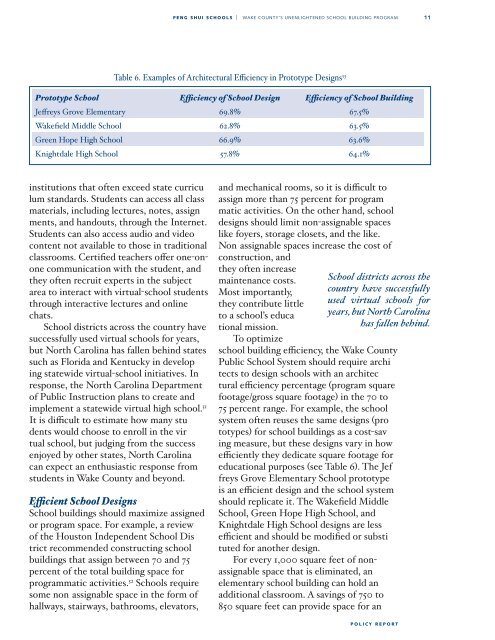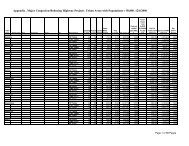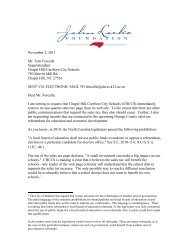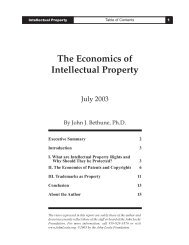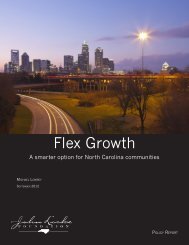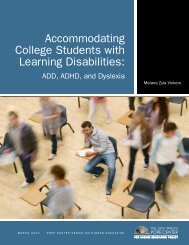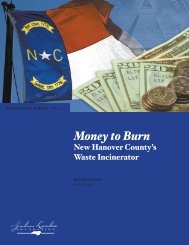Feng Shui Schools - John Locke Foundation
Feng Shui Schools - John Locke Foundation
Feng Shui Schools - John Locke Foundation
Create successful ePaper yourself
Turn your PDF publications into a flip-book with our unique Google optimized e-Paper software.
f e n g s h u i s c h o o l s |<br />
wake County’s unenlightened school building program<br />
11<br />
Table 6. Examples of Architectural Efficiency in Prototype Designs 53<br />
Prototype School Efficiency of School Design Efficiency of School Building<br />
Jeffreys Grove Elementary 69.8% 67.5%<br />
Wakefield Middle School 62.8% 63.5%<br />
Green Hope High School 66.9% 63.6%<br />
Knightdale High School 57.8% 64.1%<br />
institutions that often exceed state curriculum<br />
standards. Students can access all class<br />
materials, including lectures, notes, assignments,<br />
and handouts, through the Internet.<br />
Students can also access audio and video<br />
content not available to those in traditional<br />
classrooms. Certified teachers offer one-onone<br />
communication with the student, and<br />
they often recruit experts in the subject<br />
area to interact with virtual-school students<br />
through interactive lectures and online<br />
chats.<br />
School districts across the country have<br />
successfully used virtual schools for years,<br />
but North Carolina has fallen behind states<br />
such as Florida and Kentucky in developing<br />
statewide virtual-school initiatives. In<br />
response, the North Carolina Department<br />
of Public Instruction plans to create and<br />
implement a statewide virtual high school. 51<br />
It is difficult to estimate how many students<br />
would choose to enroll in the virtual<br />
school, but judging from the success<br />
enjoyed by other states, North Carolina<br />
can expect an enthusiastic response from<br />
students in Wake County and beyond.<br />
Efficient School Designs<br />
School buildings should maximize assigned<br />
or program space. For example, a review<br />
of the Houston Independent School District<br />
recommended constructing school<br />
buildings that assign between 70 and 75<br />
percent of the total building space for<br />
programmatic activities. 52 <strong>Schools</strong> require<br />
some non-assignable space in the form of<br />
hallways, stairways, bathrooms, elevators,<br />
and mechanical rooms, so it is difficult to<br />
assign more than 75 percent for programmatic<br />
activities. On the other hand, school<br />
designs should limit non-assignable spaces<br />
like foyers, storage closets, and the like.<br />
Non-assignable spaces increase the cost of<br />
construction, and<br />
they often increase<br />
maintenance costs.<br />
Most importantly,<br />
they contribute little<br />
to a school’s educational<br />
mission.<br />
To optimize<br />
school building efficiency, the Wake County<br />
Public School System should require architects<br />
to design schools with an architectural<br />
efficiency percentage (program square<br />
footage/gross square footage) in the 70 to<br />
75 percent range. For example, the school<br />
system often reuses the same designs (prototypes)<br />
for school buildings as a cost-saving<br />
measure, but these designs vary in how<br />
efficiently they dedicate square footage for<br />
educational purposes (see Table 6). The Jeffreys<br />
Grove Elementary School prototype<br />
is an efficient design and the school system<br />
should replicate it. The Wakefield Middle<br />
School, Green Hope High School, and<br />
Knightdale High School designs are less<br />
efficient and should be modified or substituted<br />
for another design.<br />
For every 1,000 square feet of nonassignable<br />
space that is eliminated, an<br />
elementary school building can hold an<br />
additional classroom. A savings of 750 to<br />
850 square feet can provide space for an<br />
School districts across the<br />
country have successfully<br />
used virtual schools for<br />
years, but North Carolina<br />
has fallen behind.<br />
p o l i c y r e p o r t


